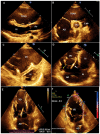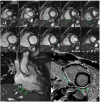[Clinical profile and therapeutic strategies in patients with arrhythmogenic cardiomyopathy treated in a national reference institute]
- PMID: 37727260
- PMCID: PMC10506560
- DOI: 10.47487/apcyccv.v2i1.123
[Clinical profile and therapeutic strategies in patients with arrhythmogenic cardiomyopathy treated in a national reference institute]
Abstract
Objective: To determine the epidemiological, clinical, electrocardiographic, imaging characteristics and main therapeutic strategies performed in patients with arrhythmogenic cardiomyopathy treated in a national reference cardiovascular institute.
Materials and methods: Observational, descriptive and retrospective study that attempts to identify the clinical characteristics, complementary tests and therapeutic strategies performed in patients with arrhythmogenic cardiomyopathy treated at the Instituto Nacional Cardiovascular - INCOR EsSalud in Lima, Peru.
Results: Thirteen patients were found with arrhythmogenic cardiomyopathy. The median age at which the diagnosis was made was 38.2 years and 69.3% were male. The most frequent clinical manifestations were tachycardic palpitations (92.3%), presyncope (84.6%) and heart failure (69.2%). 23% of the patients suffered a cardiac arrest. All the patients presented at least one episode of ventricular tachycardia, 92.3% with complete left bundle branch block morphology and upper axis. 76.9% received an implantable cardioverter defibrillator (ICD), 15.3% underwent ablation and 15.3% received a heart transplant. 84.6% of the patients live to this day.
Conclusions: Arrhythmogenic cardiomyopathy predominantly affected the young and male population. All the patients had a potentially fatal ventricular arrhythmia. Biventricular disease by echocardiography and cardiac magnetic resonance occurred in 69.2% and 100% of the cases, respectively. The therapeutic strategies used were antiarrhythmic medical treatment, placement of an ICD as secondary prevention, ablation, and heart transplantation. To date, 84.6% of patients survive.
Objetivo.: Determinar las características epidemiológicas, clínicas, electrocardiográficas, imagenológicas y principales estrategias terapéuticas realizadas en los pacientes con cardiomiopatía arritmogénica tratados en un instituto cardiovascular de referencia nacional.
Materiales y métodos.: Estudio observacional, descriptivo y retrospectivo que busca identificar las características clínicas, exámenes complementarios y estrategias terapéuticas en pacientes con cardiomiopatía arritmogénica tratados en el Instituto Nacional Cardiovascular - INCOR EsSalud en Lima - Perú.
Resultados.: Se encontraron trece pacientes con cardiomiopatía arritmogénica. La mediana de edad en la que se realizó el diagnóstico fue 38,2 años y el 69,3% de los afectados era de sexo masculino. Las manifestaciones clínicas más frecuentes fueron las palpitaciones taquicárdicas (92,3%), el presíncope (84,6%) y la falla cardiaca (69,2%). El 23% de los pacientes sufrió un arresto cardiaco. Todos presentaron, al menos, un episodio de taquicardia ventricular, el 92,3% con morfología de bloqueo completo de rama izquierda y eje superior. Al 76,9% se le colocó un desfibrilador automático implantable (DAI), al 15,3% se le realizó ablación y al 15,3% un trasplante cardiaco. El 84,6% de los pacientes vive hasta la actualidad.
Conclusiones.: La cardiomiopatía arritmogénica afectó predominantemente a población joven y de sexo masculino. Todos los pacientes tuvieron una arritmia ventricular potencialmente fatal. La afección biventricular por ecocardiografía y por resonancia magnética cardiaca se evidenció en el 69,2 y 100% de los casos, respectivamente. Las estrategias terapéuticas empleadas fueron el tratamiento médico antiarrítmico, colocación de un DAI como prevención secundaria, la ablación y el trasplante cardíaco. Hasta la actualidad, el 84,6% de los pacientes sobrevive.
Keywords: Arrhythmogenic Right Ventricular Dysplasia; Death, Sudden; Tachycardia, Ventricular.
Conflict of interest statement
Conflictos de interés: Los autores declaran no tener ningún conflicto de interés.
Figures





Similar articles
-
Long-term follow-up of arrhythmogenic right ventricular cardiomyopathy patients with an implantable cardioverter-defibrillator for prevention of sudden cardiac death.Clin Cardiol. 2017 Apr;40(4):216-221. doi: 10.1002/clc.22648. Epub 2017 Jan 31. Clin Cardiol. 2017. PMID: 28139837 Free PMC article.
-
Implantable cardioverter defibrillators in arrhythmogenic right ventricular dysplasia/cardiomyopathy: patient outcomes, incidence of appropriate and inappropriate interventions, and complications.Circ Arrhythm Electrophysiol. 2013 Jun;6(3):562-8. doi: 10.1161/CIRCEP.113.000392. Epub 2013 May 14. Circ Arrhythm Electrophysiol. 2013. PMID: 23673907 Review.
-
Implantable Cardioverter-Defibrillator Therapy in Arrhythmogenic Right Ventricular Dysplasia/Cardiomyopathy: Predictors of Appropriate Therapy, Outcomes, and Complications.J Am Heart Assoc. 2017 Jun 6;6(6):e006242. doi: 10.1161/JAHA.117.006242. J Am Heart Assoc. 2017. PMID: 28588093 Free PMC article.
-
Arrhythmogenic right ventricular cardiomyopathy: current diagnostic and management strategies.Cardiol Rev. 2001 Sep-Oct;9(5):259-65. doi: 10.1097/00045415-200109000-00005. Cardiol Rev. 2001. PMID: 11520449 Review.
-
Outcomes after catheter ablation of ventricular tachycardia without implantable cardioverter-defibrillator in selected patients with arrhythmogenic right ventricular cardiomyopathy.Europace. 2021 Sep 8;23(9):1428-1436. doi: 10.1093/europace/euab172. Europace. 2021. PMID: 34427302
References
-
- Cox M, Zwaag P, Van der Werf C, Van der Smagt J, Noorman M, Bhuiyan A, et al. Arrhythmogenic right ventricular dysplasia/cardiomyopathy clinical perspective pathogenic desmosome mutations in index-patients predict outcome of family screening: Dutch arrhythmogenic right ventricular dysplasia/ cardiomyopathy genotype-phenotype follow-up study. Circulation. 2011;123:2690–2700. doi: 10.1161/CIRCULATIONAHA.110.988287. - DOI - PubMed
Publication types
LinkOut - more resources
Full Text Sources
